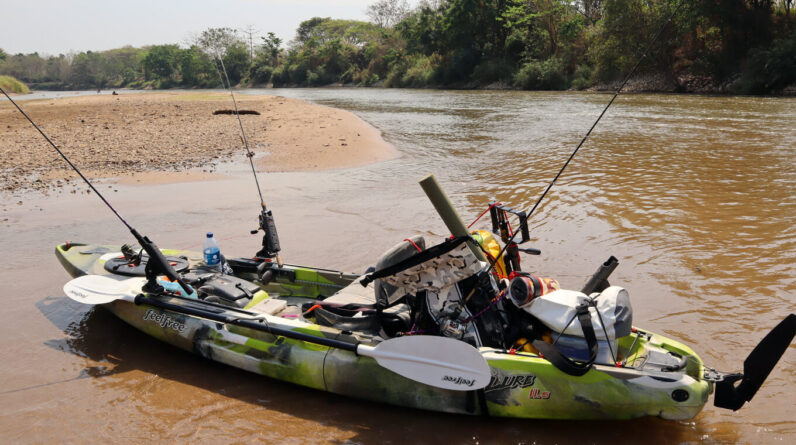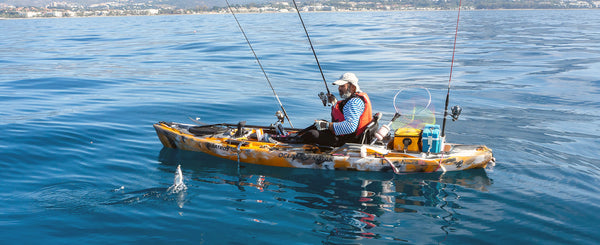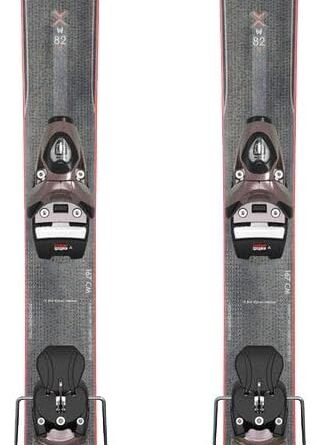
So, you’ve decided to embark on a new adventure – freshwater kayak fishing! But before you cast your line into the water, it’s important to choose the right fishing tackle. With so many options out there, it can be overwhelming for beginners. Don’t worry, though – in this beginner’s guide, we’ll break down the different types of fishing tackle and help you make an informed decision. From rods and reels to lines and lures, we’ve got you covered. Get ready to reel in those big catches and make unforgettable memories on the water!
Choosing the Right Fishing Rod
When it comes to choosing the right fishing rod for freshwater kayak fishing, there are a few factors to consider. One of the most important factors is the length of the rod. Typically, shorter rods between 5 to 7 feet long are recommended for kayak fishing. These shorter rods allow for easier maneuverability in the confined space of a kayak.
In addition to length, you’ll also want to consider the power and action of the rod. Power refers to the rod’s strength or the amount of pressure it can handle, while action refers to how much the rod bends when pressure is applied. For kayak fishing, a medium-power rod with a fast action is generally a good choice. This provides enough strength to handle larger fish while still being sensitive enough to feel the bites.
Lastly, consider the material of the fishing rod. There are various materials available, including graphite, fiberglass, and composite. Graphite rods are popular due to their lightweight and sensitivity, making them a great choice for kayak fishing. Fiberglass rods, on the other hand, offer more durability and strength. Composite rods combine the best of both materials, offering a balance between sensitivity and durability.
Selecting the Ideal Fishing Reel
Choosing the right fishing reel for your freshwater kayak fishing adventures is crucial. One of the first decisions to make is determining the reel type. There are two main types to choose from: spinning reel and baitcasting reel. Spinning reels are generally easier to use for beginners and are well-suited for a wide range of fishing techniques. Baitcasting reels, on the other hand, offer more casting accuracy and control, making them a popular choice for experienced anglers.
Another important factor to consider is the gear ratio of the reel. The gear ratio determines the speed at which the line is retrieved. Higher gear ratios provide quicker line retrieval, which can be beneficial in certain situations. For kayak fishing, a gear ratio in the range of 6:1 to 7:1 is recommended.
When it comes to reel size, it’s important to choose one that is appropriate for the rod you are using. The reel should be balanced with the rod to ensure smooth and comfortable fishing. Additionally, consider the reel material. Reels are commonly made of aluminum or graphite. Aluminum reels offer more durability and strength, while graphite reels are generally lighter and more corrosion-resistant.
This image is property of www.captainexperiences.com.
Picking the Right Fishing Line
Selecting the right fishing line is essential for a successful freshwater kayak fishing trip. One of the first considerations is the line material. There are various options available, including monofilament, fluorocarbon, and braided lines. Monofilament lines are popular for their versatility and affordability. Fluorocarbon lines are known for their invisibility underwater and abrasion resistance. Braided lines offer excellent strength and sensitivity.
Another important factor to consider is the line weight. The line weight refers to the strength of the line and is typically indicated by a number, such as 6lb or 10lb. Choosing the appropriate line weight depends on the size of the fish you are targeting and the fishing technique you will be using. Lighter lines are suitable for smaller fish and finesse techniques, while heavier lines are necessary for larger fish or fishing in heavy cover.
In addition to material and weight, the line color can also play a role in your fishing success. The color of the line can affect how visible it is to fish in the water. Clear or low-visibility colors are often preferred to avoid spooking fish, but certain situations may call for high-visibility lines, such as when fishing in low-light conditions or in thick cover.
Selecting the Proper Fishing Lures
Choosing the right fishing lures for freshwater kayak fishing can make a significant difference in your catch rate. When selecting lures, consider the fish species you are targeting. Different fish species have different feeding habits and preferences, so it’s important to choose lures that mimic their natural prey. Researching the feeding habits of your target fish can help you determine the most appropriate lure types.
Next, consider the fishing technique you will be using. Different techniques, such as casting, trolling, or jigging, require different types of lures. For example, if you plan on trolling, you’ll want to choose lures that are designed for trolling and can maintain their action at different speeds. If you prefer casting, select lures that are easy to cast and retrieve.
Along with lure types, lure colors can also play a role in attracting fish. Many anglers believe that the color of a lure can make a difference in its effectiveness. Brightly colored lures can be more visible in murky water or attract fish in low-light conditions, while natural or subtle colors can be more effective in clear water. Experimenting with different colors can help you determine what works best in your fishing environment.

This image is property of cdn.shopify.com.
Exploring the Different Fishing Baits
When it comes to freshwater kayak fishing, choosing the right fishing bait can be just as important as selecting the right lures. There are two main types of fishing bait to consider: live bait and artificial bait.
Live bait options include worms, minnows, leeches, and insects. Live bait can be incredibly effective in attracting a wide range of fish species. It provides a natural scent and movement that can entice fish to bite. However, using live bait requires proper storage and handling to keep it fresh and lively.
On the other hand, artificial bait options include soft plastic baits, crankbaits, spoons, and spinners. Artificial baits come in a variety of shapes, sizes, and colors, allowing you to mimic the appearance and movement of natural prey. They are convenient to use and don’t require the maintenance and care that live bait does.
The choice between live bait and artificial bait ultimately comes down to personal preference and the fishing conditions. Live bait can be more effective in certain situations, while artificial baits offer versatility and convenience. It’s always a good idea to have both options available to increase your chances of success.
Understanding Fishing Hooks
Selecting the right fishing hooks is crucial for ensuring a solid hookset and landing your catch. When choosing fishing hooks, one important factor to consider is the hook size. Hook sizes are indicated by numbers, with smaller numbers representing larger hooks. The hook size you choose should be appropriate for the fish species you are targeting and the bait or lure you will be using. A larger hook may be needed for larger fish or when using larger baits or lures.
Another consideration is the hook style. There are various hook styles available, including J-hooks, circle hooks, and treble hooks. J-hooks are the most common and versatile, suitable for a wide range of fishing techniques. Circle hooks are popular for catch-and-release fishing, as they tend to hook the fish in the corner of the mouth, reducing the risk of injury. Treble hooks have multiple points and are commonly used on lures.
Lastly, choose a hook material that is appropriate for the fishing conditions. Hooks are typically made of stainless steel or high-carbon steel. Stainless steel hooks offer excellent corrosion resistance, making them ideal for saltwater fishing. High-carbon steel hooks are stronger and more durable, making them a good choice for targeting larger fish or fishing in heavy cover.

This image is property of www.gilisports.com.
Examining Fishing Weights and Sinkers
Fishing weights and sinkers are essential for keeping your bait or lure at the desired depth and improving casting distance. When choosing weights, consider the weight size. Weight sizes are indicated in ounces, with lighter weights for finesse fishing and heavier weights for deep-sea fishing or fishing in strong currents. It’s a good idea to have a variety of weight sizes available to adapt to different fishing conditions.
In addition to weight size, consider the different weight shapes and materials available. Weight shapes include bullet weights, pyramid sinkers, and egg sinkers, among others. Each shape is designed with a specific purpose in mind. For example, bullet weights are commonly used for Texas rigging, while pyramid sinkers are effective for holding bottom positions in strong currents. Weight materials can vary from lead to tungsten, with tungsten being denser and less environmentally harmful.
Choosing the right weight shape and material can have an impact on your fishing success. Different shapes and materials can affect how the weight moves through the water, how it affects the action of your bait or lure, and its resistance against currents. Experimenting with different weight options can help you determine what works best for your fishing style and environment.
Selecting the Right Fishing Floats or Bobbers
Fishing floats or bobbers are useful tools for indicating bites and keeping your bait at a specific depth. When choosing floats, consider the different float types available. There are various types, including traditional round bobbers, slip bobbers, and foam floats. Round bobbers are commonly used for simple fishing techniques and are easy to attach to your fishing line. Slip bobbers are adjustable, allowing you to set the depth at which your bait is suspended. Foam floats are buoyant and can provide additional visibility.
Float size is another important consideration. Float sizes can vary depending on the weight they need to support. A larger float may be needed for heavier baits or lures, while a smaller float is suitable for lighter setups. It’s important to choose a float size that keeps your bait at the desired depth without causing excessive resistance.

This image is property of media.wired2fish.com.
Understanding Fishing Swivels
Fishing swivels play an important role in preventing line twist and improving the action of your bait or lure. When it comes to choosing fishing swivels, one important factor to consider is the swivel size. Swivel sizes are indicated by numbers, with larger numbers representing smaller swivels. The swivel size you choose should be appropriate for the fishing line and tackle you are using. Using a swivel that is too small can cause line breakage, while using a swivel that is too large can affect the action of your bait or lure.
Another consideration is the swivel material. Fishing swivels are commonly made of brass or stainless steel. Brass swivels are more affordable and work well for most fishing applications. Stainless steel swivels offer superior strength and corrosion resistance, making them ideal for saltwater fishing or targeting larger fish.
Choosing the right swivel size and material can help ensure a smooth fishing experience and increase the longevity of your fishing line and tackle. Properly attaching swivels to your fishing line can help prevent line twist caused by the rotation of baits or lures, allowing for a more natural presentation and improved fishing success.
Picking the Appropriate Leader Material
A leader is a length of fishing line that is attached to the mainline and serves as a connection between the mainline and the bait or lure. When choosing leader material, consider the leader material strength. Leader material is typically stronger than the mainline to withstand the abrasion caused by fish teeth or rough underwater structures. The strength you choose should be appropriate for the fish species you are targeting and the fishing conditions.
In addition to strength, consider the leader length. Leader lengths can vary depending on the fishing technique and conditions. Longer leaders may be necessary for fish that are easily spooked or in clear water conditions. Shorter leaders can provide better control and accuracy when casting or trolling. Experimenting with different leader lengths can help you determine what works best for your fishing style and environment.
Selecting the right leader material is crucial for ensuring the success of your freshwater kayak fishing trips. A strong and durable leader can provide the confidence needed to land that prized catch and prevent unnecessary line breakage or damage to your mainline. Take the time to research and choose a leader material that suits your fishing needs.

This image is property of www.kayaks2fish.com.
Conclusion
Choosing the right fishing tackle for freshwater kayak fishing is essential for a successful and enjoyable fishing experience. By considering the length, power, and action of the fishing rod, the type, gear ratio, and size of the fishing reel, the material and weight of the fishing line, the targeted fish species and fishing technique when selecting lures, the choice between live bait and artificial bait, the size, style, and material of fishing hooks, the weight size, shape, and material of fishing weights and sinkers, the type and size of fishing floats or bobbers, the size and material of fishing swivels, and the strength and length of the leader material, you can ensure that you have the appropriate fishing tackle for various fishing conditions and improve your chances of catching more fish. Happy fishing!







